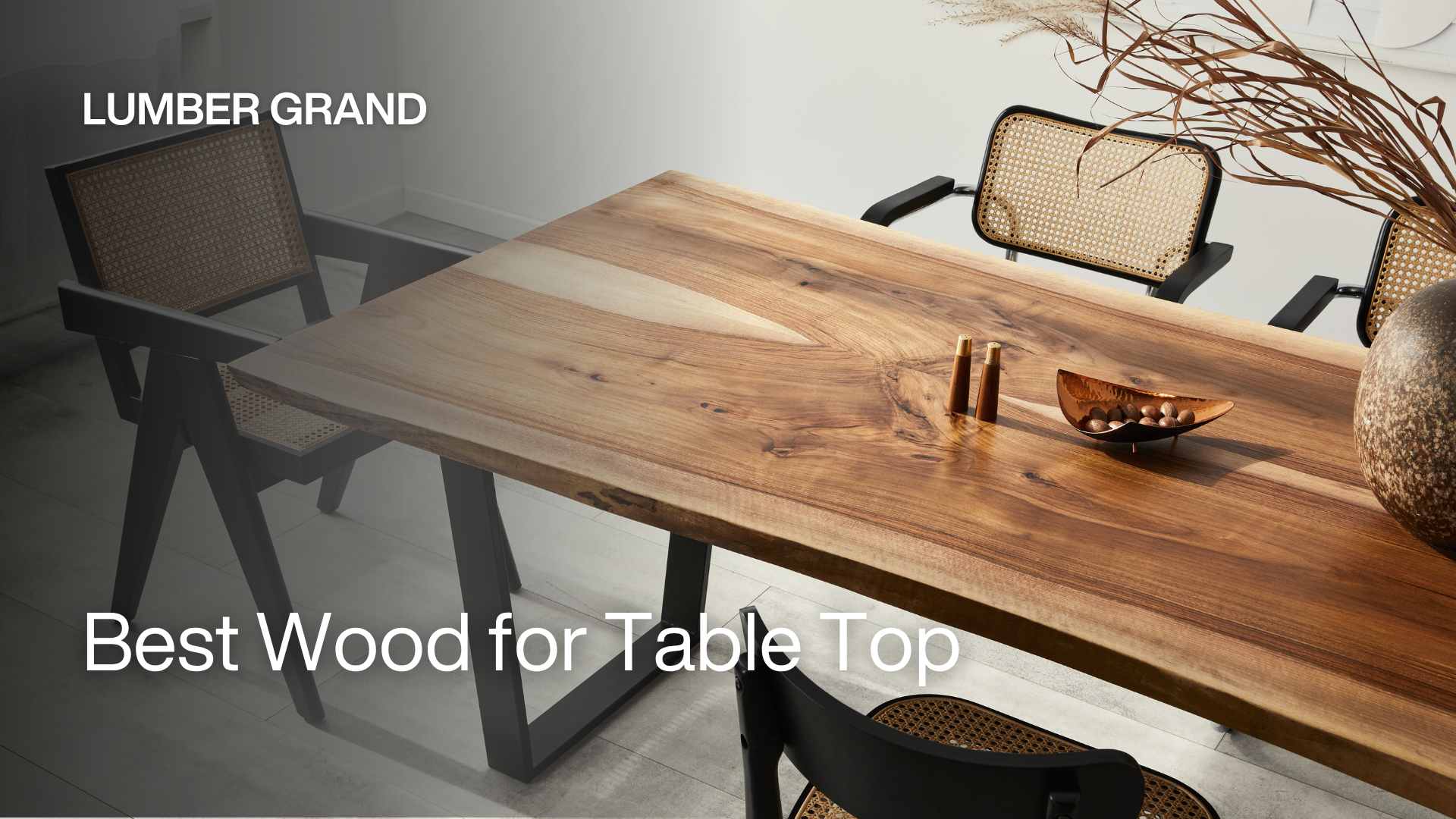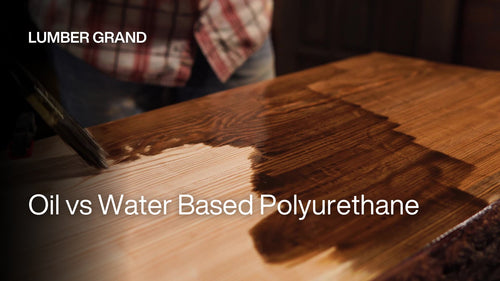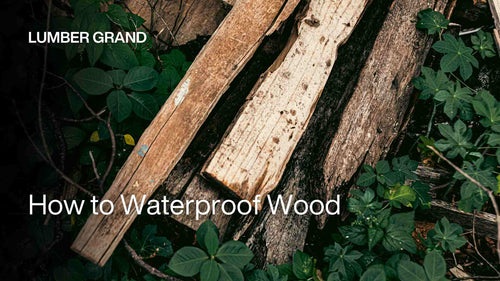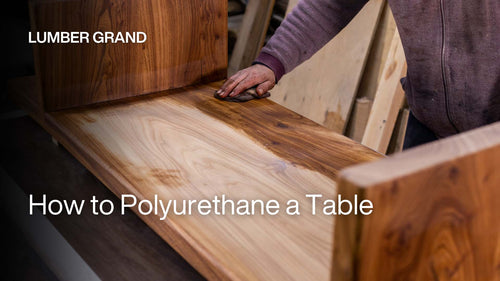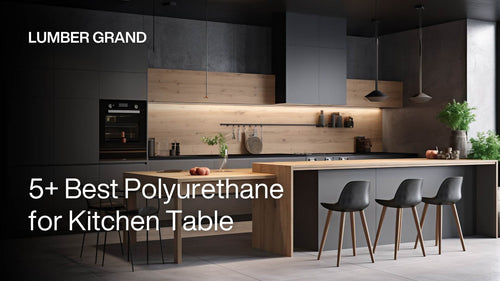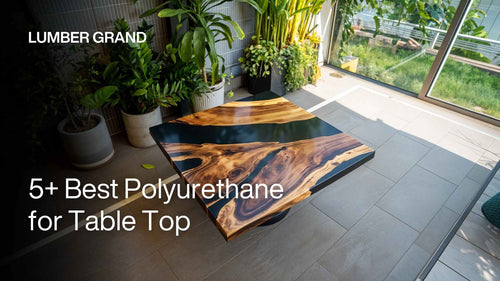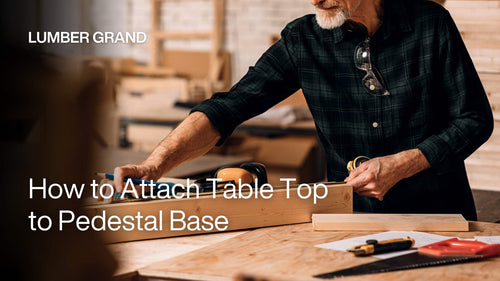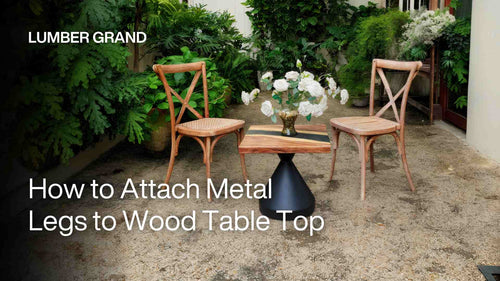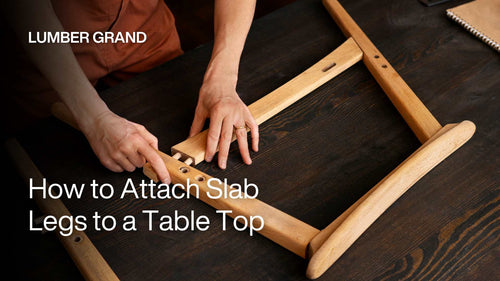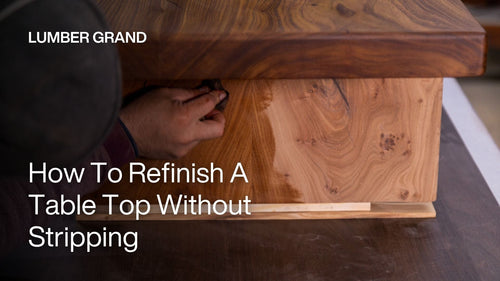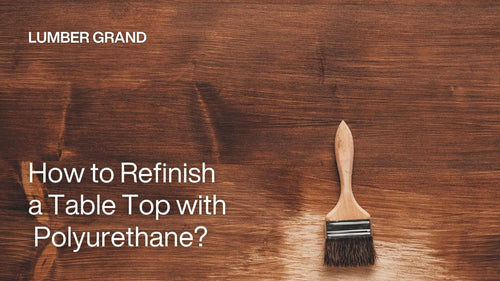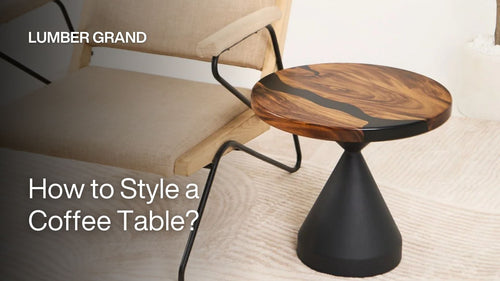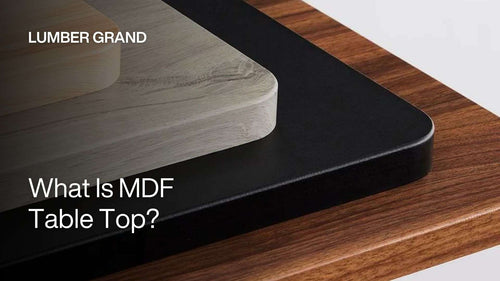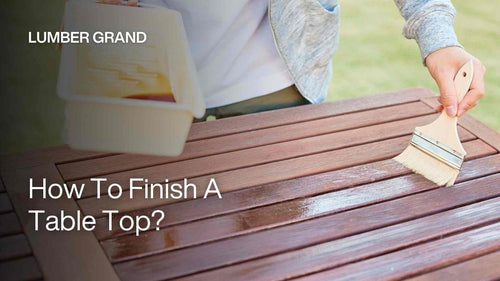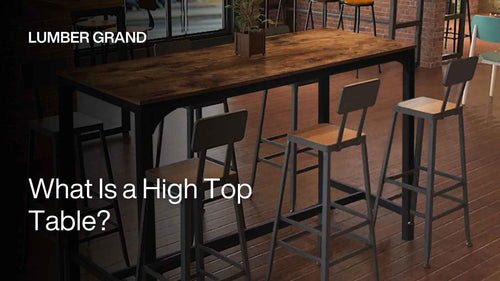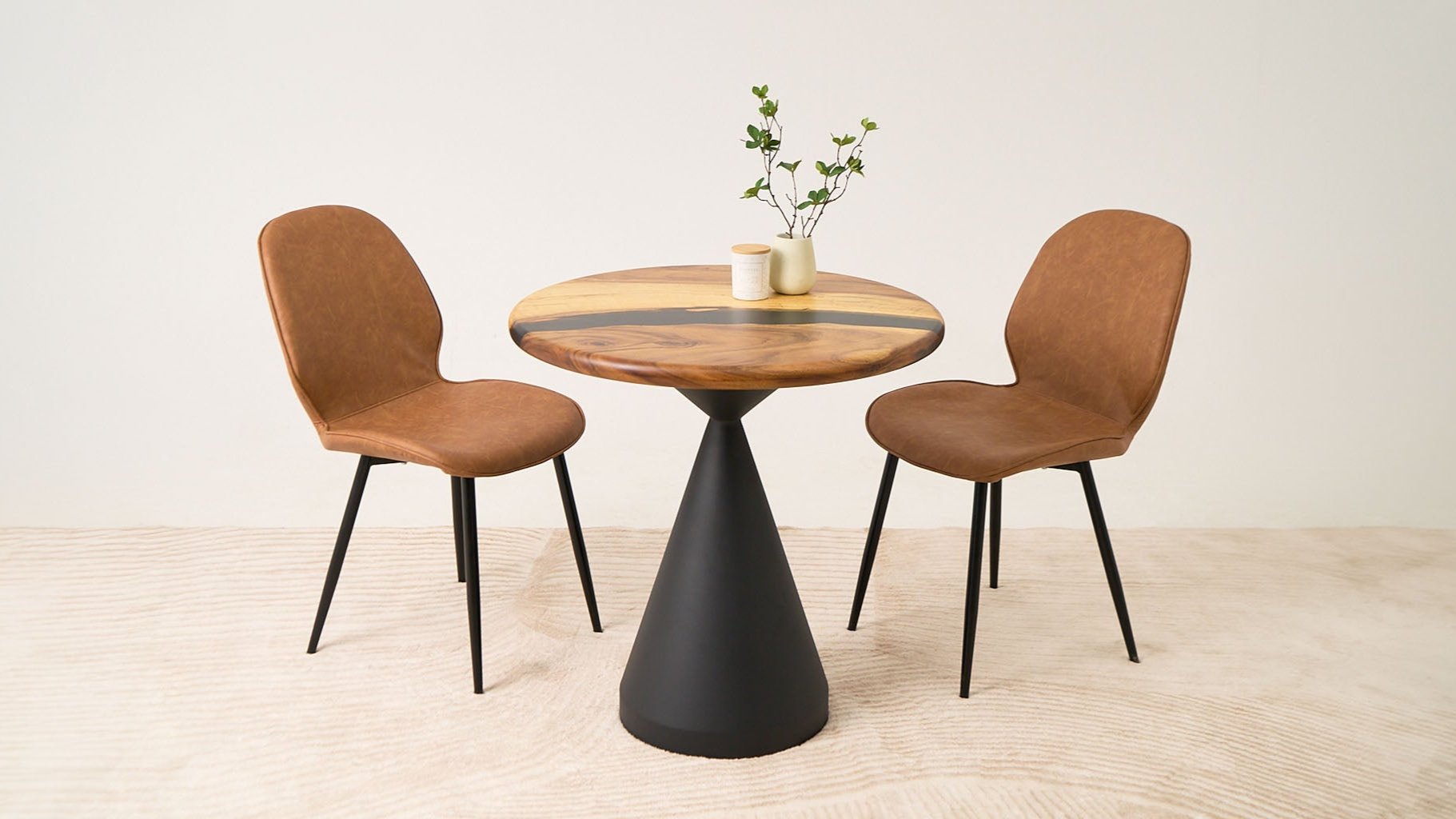With many of the best wood for table top like walnut, mahogany, cherry, oak, etc., it's hard to figure out what actually suits you.
- A poor wood choice for a table top can lead to warping, scratches, or cracks that appear way too soon.
- But the best wood types for a table top are not only durable but also elegantly designed for your home.
After years of working with countless wood types and seeing which ones truly stand the test of time, Lumber Grand has narrowed down the absolute 8 best wood for dining table tops. Our team reveals the top wood choices that combine beauty, strength, and practicality. Read more!
8 Best Wood for Table Top: Quick Comparison Table
We've gathered information about the best woods for table tops, all in one easy-to-follow table. Still, the price might be different at the time you read this blog. So, don’t forget to double-check the market for the exact wood price.
|
Specification |
Janka Hardness |
Price per Board Foot |
Weight |
Moisture Resistance |
Finishing Properties |
Natural Resistance |
|
Hard Maple |
1,450 |
$4 — $8 |
44.0 |
Poor |
Takes stain well with pre-conditioner |
Susceptible to decay/insects |
|
White Oak |
1,360 |
$3 — $16.8+ |
47.0 |
Excellent |
Stains and finishes well |
High rot/decay resistance |
|
Red Oak |
1,290 |
$4 — $6 |
- |
Poor |
Excellent stain acceptance |
Poor decay resistance |
|
Black Walnut |
1,010 |
$12 — $18+ |
- |
Good |
Rarely needs staining |
Good decay resistance |
|
Cherry |
995 |
$5 — $20 |
35.0 |
Poor-Fair |
Prone to blotching, needs a sealer |
Moderate (heartwood only) |
|
Quarter Sawn White Oak |
1,350 |
25 — 50% premium over plain White Oak |
47.0 |
Excellent |
Stains evenly |
Excellent rot/decay resistance |
|
Soft Maple |
700 — 950 |
$6.75 — $15+ |
32 — 38 |
Fair-Poor |
Takes stains very well |
Poor rot resistance |
|
Mahogany |
800 |
$12.5 — $14.5+ |
36.8 |
Good-Excellent |
Accepts all finishes exceptionally |
Moderate to excellent |
What Makes the Best Wood for Table Top?
You're making a smart choice by doing your research first. The best wood for a table top can last for generations, but only if you pick the right wood for table top that fits your needs and lifestyle.
Here are 6 vital things of a good wooden table top that you should look for:
-
Moisture Resistance: The best wood for dining table top needs to handle spilled wine, sweaty glasses, and the occasional forgotten wet dish without staining or warping. Some woods shrug off moisture like it's nothing. Meanwhile, others are more sensitive.
-
Stability: Nobody wants a wobbly table that warps when the weather changes. Best wood for table top stays nice and flat, whether it's humid summer or dry winter. This matters most for big tables where even small movements can make joints come apart or create an uneven surface that makes your coffee cup slide around.
-
Durability: Your table needs to handle whatever life throws at it. The toughness of wood is measured by something called a Janka rating. Woods scoring above 1,200 are the honor students who can take a beating. Anything below 1,000 shows scratches and dents quickly if your family is hard on furniture.

The Janka rating (Janka hardness test) is a measure of the hardness of wood
Data: Wood handbook: Wood as an engineering material, USDA
Photo: Lumber Grand
-
Grain Pattern: Wood grain is like fingerprints, and every piece is different. Some people love bold, dramatic patterns with swirls and color changes. Others prefer something quiet and subtle that won't compete with their decor. So, don’t forget to think about what wood makes you happy when you look at it every day.
-
Workability Maintenance: Some woods are high-maintenance drama queens, while others are easy-going. The best choices take stain evenly (no blotchy spots), are simple to finish when building, and don't need constant babying to look good. You’ll want wood that ages gracefully without demanding a lot of fuss.
-
Ages Well: Just like people, wood changes as it gets older. Some woods get richer and more beautiful with time, while others might darken significantly or fade due to UV exposure. Consider how you want your table to look in 10 or 20 years.
Read more: How Thick Should a Dining Table Top Be
8 Best Wood for Table Top that You Should Know
If you're looking for the right wood to build or customize your table top, it's good to know what each has to offer. Some are better suited for heavy everyday use, while others are for intense character or outdoor weathering.
Here are the top 8 popular types of wood for table tops to consider.
1. Hard Maple: Best Hardwood for Table Top Overall
If you want a dining table that can handle anything your family dishes out, hard maple is your champion. This best wood for table tops dining, tough enough for the busiest family kitchens, and elegant enough for fancy dinner parties.

Hard maple is ideal if you need wood table top with exceptional durability and hardness
Photo: Freepik
Additionally, hard maple scores 1,450 lbf on that toughness scale we mentioned earlier. That means when your little kid drops his plate or Grandma accidentally knocks over her water glass, your table just shrugs it off.
Heavy casserole dishes, sharp knives that slip, those inevitable scratches from daily life — hard maple takes it all in stride.
Key characteristics:
-
Light, creamy color with uniform grain patterns
-
Exceptional durability, perfect for high-traffic dining areas
-
Clean, contemporary aesthetic ideal for modern homes
-
Superior stain absorption for custom finishes
Best for: Kitchen tables, best wood for coffee table projects, modern dining furniture
You might like: Best Finish for Outdoor Wood Furniture
2. White Oak: Best Wood for Table Top Outdoor
White oak has tiny natural plugs inside its wood fibers that work like millions of microscopic corks, blocking water from getting in.
Combined with a respectable toughness score of 1,360 lbf, this wood can handle whatever Mother Nature throws at it — rain, snow, blazing sun, you name it.

White Oak flooring can cost as much as $11 — $13 per square foot
Photo: Freepik
While other woods require expensive treatments and constant babying, white oak comes naturally equipped with its own protection system.
It's packed with natural compounds called tannins (the same thing that makes wine taste dry) and has such a tight grain that bugs, rot, and moisture just can't get a foothold.
Key characteristics:
-
Light to medium brown color that weathers beautifully
-
Natural moisture resistance is perfect for outdoor use
-
Tight grain pattern with exceptional stability
-
Signature choice for Mission-style furniture
Best for: Outdoor dining tables, patio furniture, traditional indoor tables
3. Red Oak: Most Affordable Wood for Table Top DIY Projects
Sometimes the best wood isn't the most expensive one. Red oak proves that you can get a stunning best wood for table top without breaking the bank. With a rating of 1,290 lbf, red oak is strong enough for daily use but gentle enough on your budget.

Red Oak, scientifically known as Quercus rubra, is a widely used hardwood in the eastern US
Photo: Flickr
Inexpensive wood for table top is due to the fact that red oak grows practically everywhere in North America. From the forests of Maine down to Georgia and west into Canada, red oak trees are thriving.
When something grows abundantly close to home, it doesn't cost a fortune to harvest and ship. That's economics working in your favor. More trees nearby mean better prices for you.
Key characteristics:
-
Warm, reddish-brown hue with pronounced grain patterns
-
Superior stain absorption for custom color options
-
High durability at an accessible price point
-
Widely available across North America
Best for: Traditional dining tables, Victorian-style furniture, budget-friendly projects
4. Walnut: Best Natural Elegance Wood Grain for Dining Table Top
If you're looking for a dining table that makes guests stop and say "wow," walnut is your answer.
This best wood for dining table top is stunning, sophisticated, and absolutely unforgettable. Now, walnut has a rating of 1,010 lbf, but that is perfectly fine for most homes.

Walnut wood is well-known for being an expensive hardwood, and there are several reasons why
Photo: Pavel Vaschenkov/Shutterstock)
What makes walnut so pricy among types of wood for table tops? Every walnut board tells its own story. Some have perfectly straight lines that look like cathedral windows reaching toward the sky. Others swirl and dance with curly patterns that move as you walk around the table.
The really special pieces have burls — those incredible whorl patterns that look like nature's own fingerprints. These unique boards are so prized that collectors will pay premium prices just to own them.
Key characteristics:
-
Deep chocolate-brown heartwood with lighter sapwood contrast
-
Pronounced straight grain with occasional swirls, burls, and figure patterns
-
Moderate durability requires careful maintenance in high-traffic areas
-
Natural color variations make each board unique
-
Ages to deeper, richer brown tones with golden undertones
-
Excellent dimensional stability with minimal seasonal movement
Best for: Executive conference tables, formal dining rooms, modern live-edge designs, high-end residential furniture
5. Cherry: Best Color-Evolving Wood for Table Tops
When woodworkers first cut and finish cherry, it starts out looking pretty plain. The pale, peachy-pink color might make you wonder what all the fuss is about.
But don't worry because that's just the beginning of an amazing journey to find the best wood for a table top.

Cherry wood is typically more expensive than many other hardwoods
Photo: Freepik
The real show starts when your cherry table comes home and begins soaking up the light in your dining room. It's like the wood has been sleeping and finally wakes up when it gets some sunshine.
Over the next few months and years, that modest pink transforms into the gorgeous, warm reddish-brown color that makes cherry wood famous worldwide. That's the magic of cherry wood among types of wood for table tops.
Detailed Cherry wood color evolution timeline:
-
First 30 days: Subtle shift from pale pink to light salmon
-
3 — 6 months: Noticeable warming toward golden-brown tones
-
1 — 2 years: Development of rich amber and reddish-brown depths
-
5 — 10 years: Achievement of classic deep cherry color with golden highlights
-
20+ years: Mature patina with complex color variations and natural luster
Key characteristics:
-
Color evolution from light pink to deep reddish-brown
-
Smooth texture with subtle, elegant grain patterns
-
Moderate durability (Janka rating: 995)
-
Classic choice for traditional furniture styles
Best for: Formal dining rooms, heirloom pieces, traditional decor
6. Quarter Sawn White Oak: Best Wood for Large Table Tops with Ray Fleck Patterns
Most lumber mills cut trees like you'd slice a loaf of bread, straight across in even pieces. But people cut quarter sawn white oak (QASA) more like you'd cut a pie into wedges.
Sounds simple, but this one change makes all the difference for the best hardwood for dining table.
These beautiful patterns come from the tree's old plumbing system. The tiny channels that carried water and nutrients when it was growing.
When the light hits them just right, they sparkle and shine like someone sprinkled glitter across your table. Walk around the room, and the patterns seem to follow you, changing and shifting as you move.

Quarter sawn white oak is a dense hardwood that varies in color from light grayish-tan to brown
Photo: North Castle Hardwoods
Yet, the practical part of this best wood for table top stays flat as a pancake. You know how some wood furniture warps or bends over time? Not this wood.
The special way it's cut makes it incredibly stable, even if you want a big family table that seats up to 12 people for Sunday dinner.
Key characteristics:
-
Distinctive ray flecks creating unique grain patterns
-
Superior moisture resistance and stability
-
Classic yet contemporary aesthetic appeal
-
Higher investment with excellent long-term value
Best for: Mission furniture, large dining tables, contemporary designs
Read more: How to Polyurethane a Table
7. Soft Maple: Versatile Wood for Table Top DIY Projects
"Soft" maple got its nickname only because it's not quite as hard as its tough-guy cousin, hard maple.
But with a solid hardness rating of 950 lbf, this wood is actually tougher than cherry and plenty of other fancy imported woods you'd pay twice as much for.

Soft maple is usually cheaper than hard maple because it has uneven coloring
Photo: Freepik
We like working with this 8th best wood for table top. Soft maple practically wants to cooperate with you in every DIY table top project:
-
When you cut it, it slices clean without those annoying splinters that ruin your day.
-
When you glue pieces together, they stick like they were meant to be together.
-
Whether you're using hand tools like your grandfather did or modern power tools, soft maple responds exactly the way you'd expect it to.
Most importantly, as the years go by, soft maple develops this warm, golden glow that just gets more appealing with time. It ages gracefully, like a good friend who only gets better with the years.
Key characteristics:
-
Light blonde to reddish-brown natural coloring
-
Develops attractive golden hues with age
-
Good durability-to-price ratio
-
Excellent for staining and custom finishes
Best for: Transitional furniture, contemporary tables, budget-conscious quality projects
Read more: How To Refinish A Table Top Without Stripping and Sanding
8. Mahogany: Best Prestige Wood for Table Top Applications
Back in the old days, when artisans had to rely on hand tools like chisels and planes, mahogany was their favorite because it carved beautifully and didn't fight them every step of the way.
Mahogany wood has been the choice of royalty, presidents, and anyone who appreciates the finer things in the 18th and 19th centuries.
Mahogany has what craftsmen call "interlocking grain," which sounds technical but really just means the wood fibers weave together like a perfectly made basket.
Even though it's incredibly durable and prestigious, mahogany is surprisingly cooperative when you're building with it.

For the most part, Cuban Mahogany is no longer commercially available
Photo: LJExoticWood Reddit
Now, when you're shopping for mahogany, you'll want to know that there are different varieties:
-
Cuban Mahogany (Swietenia mahagoni): It's become so rare that finding it is like discovering buried treasure, and it costs about as much, too. Most people can't get their hands on it anymore.
-
Honduran Mahogany (Swietenia macrophylla): Most of the beautiful mahogany furniture you see today is made from Honduran mahogany. Honduran is the best wood for table top that delivers all the beauty and performance you'd expect.
-
African Mahogany (Khaya species): More budget-friendly, and it's also decent wood, but it's not quite in the same league as the others.
Key characteristics:
-
Deep, rich coloring associated with luxury and success
-
Tight grain structure providing superior durability
-
Excellent resistance to scratches and surface damage
-
Premium pricing reflecting exceptional quality
Best for: Executive furniture, formal dining tables, luxury home offices
You might like: Top 8 Best Wood for Epoxy Table
FAQs
1. What Wood is Best Used for Table Top?
The best wood for table tops depends on your specific needs, but hardwoods work much better than softwoods. They last longer and look better over the years. Here are the top picks:
-
Oak is incredibly strong, has gorgeous grain patterns, and can handle anything your family dishes out.
-
Maple gives you a lighter, cleaner look while being just as tough as oak.
-
Walnut has those rich, chocolate-brown colors that make people stop and admire your table. I
-
Cherry is special because it gets more beautiful as it ages.
If you're looking at your budget, ash and birch are also good choices that still give you good quality and durability without the higher price tag of premium woods.
2. What is the Most Durable Wood for a Dining Table?
Oak and hard maple are the most durable wood for a dining table. White oak is a little bit tougher than red oak, but both are excellent choices that will serve your family for generations.
Hickory is also extremely hard and tougher than all the others, but it can be tricky to work with, so you'll see it less often in furniture.
3. Is Maple or Oak Better for a Dining Table?
Regarding dining table, oak is generally a better choice than maple due to its superior durability and stability. Both of them are hardwoods, but oak has a higher Janka hardness rating than maple (1,450 vs 1,360).
4. What Wood are Most Dining Tables Made Of?
Most dining tables are made of oak, maple, or walnut. And these aren't your only choices. Cherry ages beautifully, getting richer and more gorgeous over the years. Mahogany has that classic, upscale look that's been popular for generations.
If you're looking for something more budget-friendly or want a casual, farmhouse style, pine can work too. It's softer than the hardwoods, so it won't take as much abuse, but it can be perfect for the right situation.
5. What is the Best Finish for a Wood Table Top?
Polyurethane finish is the best all-around choice for wood table tops, but the optimal finish depends on your usage patterns and maintenance preferences.
Top finish options after polyurethane that we highly recommend are: tung oil, linseed oil, varnish, danish oil, lacquer, shellac, and wax.
Read more about this finish: 5+ Best Polyurethane for Table Top
Best Wood for Table Top: Final Choice
Here’s what we’ve learned about picking the best wood for your table top:
-
Hard maple white oak — Top durability for heavy daily use
-
Red oak soft maple — Budget-friendly options without sacrificing quality
-
Walnut cherry — Premium beauty that improves with age
-
Quarter sawn white oak mahogany — Luxury choices for statement pieces
Long-term value calculations:
-
Hard maple/White oak: 30 — 50 years = excellent long-term value despite higher initial cost
-
Red oak/Soft maple: 15 — 25 years = good value for budget-conscious buyers
-
Walnut/Cherry: 25 — 40 years = premium pricing justified by beauty and aging characteristics
-
QSWO/Mahogany: 50+ years = heirloom quality that may appreciate in value
Your pick of the best wood for table top really comes down to what fits your lifestyle, your budget, and the look you want in your home. Also, do you have more ideas for designing the perfect wood table? Explore the Lumber Grand blog for expert tips, real-life inspiration, and detailed guides.

